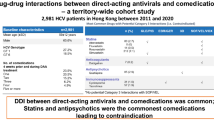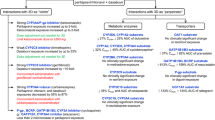Abstract
Background and Objective
Drug–drug interactions need to be considered to optimize the pharmacotherapeutic outcome of direct-acting antivirals. The aim of this study was to report on possible drug–drug interactions between ledipasvir/sofosbuvir and other medications received by children and adolescents with hepatitis C virus, in addition to suggested management for these drug–drug interactions.
Methods
Hepatitis C virus-infected children and adolescents, 12–17 years of age and/or weighing ≥ 35 kg, who presented to the Pediatric Hepatology Unit at Cairo University Pediatric Hospitals for ledipasvir/sofosbuvir treatment were included. Medication history was taken including long-term medications for chronic conditions and on-demand medications for inter-current illnesses. Medications were reviewed by the Kasr Alainy Drug Information Center to identify possible drug–drug interactions with prescribed ledipasvir/sofosbuvir and their management. HEP Drug Interactions provided by the University of Liverpool, Lexicomp®, and Medscape were the utilized references. Each drug–drug interaction was assigned a risk rating of A, B, C, D, or X.
Results
Sixty hepatitis C virus-infected children and adolescents assigned to receive ledipasvir/sofosbuvir were enrolled. Thirty percent of patients had associated chronic co-morbid conditions. The overall number of medications received was 48; 39 were prescribed as long-term medications with a median of 3 (interquartile range 4.24) medications per patient. Proton pump inhibitors, antacids, histamine H2 receptor antagonists, sodium bicarbonate, and colchicine were reported to be associated with a drug–drug interaction risk D necessitating therapy modification, which occurred prior to administration.
Conclusions
Early identification and prompt response to drug–drug interactions with the aid of pharmacists optimize the pharmacotherapeutic outcome and eliminate possible morbidities when using direct-acting antivirals in children and adolescents with hepatitis C virus.
Similar content being viewed by others
References
Kowdley KV, Gordon SC, Reddy KR, Rossaro L, Bernstein DE, Lawitz E, ION-3 Investigators, et al. Ledipasvir and sofosbuvir for 8 or 12 weeks for chronic HCV without cirrhosis. N Engl J Med. 2014;370:1879–88.
US FDA. FDA news release: FDA approves two hepatitis C drugs for pediatric patients. 2017. www.fda.gov/news-events/press-announcements/fda-approves-two-hepatitis-c-drugs-pediatric-patients. Accessed 10 May 2019.
European Medicines Agency. Harvoni (ledipasvir/sofosbuvir) film-coated tablets: EU summary of product characteristics. 2014. http://www.ema.europa.eu/. Accessed 10 May 2019.
Aasld-Idsa, HCV Guidance Panel. Hepatitis C guidance. update: AASLD-IDSA recommendations for testing, managing, and treating hepatitis C virus infection. Clin Infect Dis. 2018;2018(67):1477–92.
European Association for the Study of the Liver. EASL recommendations on treatment of hepatitis C 2018. J Hepatol. 2018;69:461–511.
Indolfi G, Hierro L, Dezsofi A, Jahnel J, Debray D, Hadzic N, et al. Treatment of chronic hepatitis C virus infection in children: a position paper by the Hepatology Committee of European Society of Paediatric Gastroenterology, Hepatology and Nutrition. J Pediatr Gastroenterol Nutr. 2018;66:505–15.
Dick T, Lindberg L, Ramirez D, Charlton M. A clinician’s guide to drug-drug interactions with direct-acting antiviral agents for the treatment of hepatitis C viral infection. Hepatology. 2016;63:634–43.
Siederdissen C, Maasoumy B, Marra F, Deterding K, Port K, Manns M, et al. Drug–drug interactions with novel all oral interferon-free antiviral agents in a large real-world cohort. Clin Infect Dis. 2016;62:561–7.
Gilead Sciences Inc. Harvoni (ledipasvir and sofosbuvir) tablets for oral use: US prescribing information. 2015. http://www.harvoni.com/. Accessed 10 May 2019.
Jimenez-Nacher I, Alvarez E, Morello J, Rodriguez-Nóvoa S, de Andrés S, Soriano V. Approaches for understanding and predicting drug interactions in HIV infected patients. Expert Opin Drug Metab Toxicol. 2011;7:457–77.
Dresser GK, Spence JD, Bailey DG. Pharmacokinetic-pharmacodynamic consequences and clinical relevance of cytochrome P450 3A4 inhibition. Clin Pharmacokinet. 2000;38:41–57.
Marquez B, Van Bambeke F. ABC multidrug transporters: target for modulation of drug pharmacokinetics in drug-drug interactions. Curr Drug Targets. 2011;12:600–20.
German P, Mathias A, Brainard DM, Kearney BP. Drug-drug interaction profile of the fixed-dose combination tablet regimen ledipasvir/sofosbuvir. Clin Pharmacokinet. 2018;57:1369–83.
University of Liverpool. 2010. HEP drug interactions. 2010. http://www.hep-druginteractions.org. Accessed 4 May 2018.
Lexicomp®. Interactions. http://www.wolterskluwercdi.com/lexicomp-online/user-guide/tools-interactions/. Accessed 3 Apr 2018.
Medscape. Drug interaction checker. 2018. https://reference.medscape.com/drug-interactionchecker. Accessed 3 Apr 2018.
Lexicomp®. Lexi-interact data fields. 2018. http://webstore.lexi.com/Information/Product-Information/Lexi-Interact-Fields. Accessed 3 Apr 2018.
Höner Zu Siederdissen C, Maasoumy B, Marra F, Deterding K, Port K, et al. Drug-drug interactions with novel all oral interferon-free antiviral agents in a large real-world cohort. Clin Infect Dis. 2016;62:561–7.
Vermehren J, Peiffer KH, Welsch C, Grammatikos G, Welker MW, Weiler N, et al. The efficacy and safety of direct acting antiviral treatment and clinical significance of drug-drug interactions in elderly patients with chronic hepatitis C virus infection. Aliment Pharmacol Ther. 2016;44:856–65.
Langness JA, Nguyen M, Wieland A, Everson GT, Kiser JJ. Optimizing hepatitis C virus treatment through pharmacist interventions: identification and management of drug-drug interactions. World J Gastroenterol. 2017;23:1618–26.
Ottman AA, Townsend ML, Hashem MG, DiMondi VP, Britt RB. Incidence of drug interactions identified by clinical pharmacists in veterans initiating treatment for chronic hepatitis C infection. Ann Pharmacother. 2018;52:763–8.
El-Karaksy HM, Mogahed EA, Abdullatif H, Ghobrial C, El-Raziky MS, Eel-Koofy N, et al. Sustained viral response in genotype 4 chronic HCV infected children and adolescents treated with sofosbuvir/ledipasvir. J Pediatr Gastroenterol Nutr. 2018;67:626–30.
Author information
Authors and Affiliations
Corresponding author
Ethics declarations
Funding
No funding was received for the preparation of this article.
Conflict of interest
Hala Mohsen Abdullatif, Rania Ramzi, Engy Adel Mogahed, Carolyne Morcos Ghobrial, Basma Abd El Rasheed Abd El Zaher, Mona S. El Raziky, and Hanaa Mostafa El-Karaksy have no conflicts of interest that are directly relevant to the content of this article.
Ethics approval
All procedures performed in studies involving human participants were in accordance with the ethical standards of the institutional and/or national research committee and with the 1964 Helsinki Declaration and its later amendments or comparable ethical standards.
Consent to participate
Informed consent was obtained from all individual participants included in the study.
Rights and permissions
About this article
Cite this article
Abdullatif, H.M., Ramzi, R., Mogahed, E.A. et al. Drug–Drug Interactions in Children and Adolescents Receiving Ledipasvir/Sofosbuvir for the Treatment of Hepatitis C Virus Infection. Clin Drug Investig 39, 857–864 (2019). https://doi.org/10.1007/s40261-019-00805-5
Published:
Issue Date:
DOI: https://doi.org/10.1007/s40261-019-00805-5




